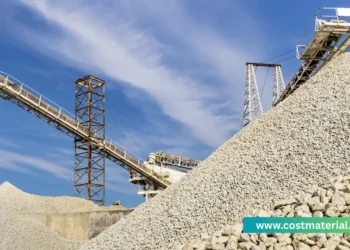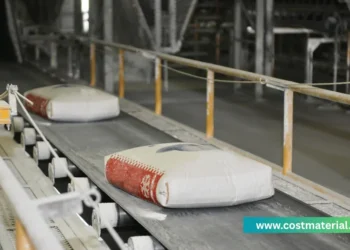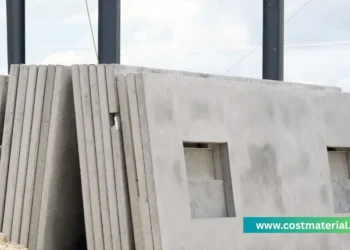Sand is a fundamental material in construction, used for concrete, plastering, backfilling, and landscaping. In this blog post, you will learn first what is the different type of sand including its different uses and important before we show the sand price list.
What is Sand?
Sand is a naturally occurring granular material composed of finely divided rock and mineral particles, typically ranging between 0.0625 mm to 2 mm in diameter. It is one of the most essential materials in construction, landscaping, and industrial applications due to its versatility, durability, and availability. Formed through the erosion of rocks over thousands of years, sand can be found in deserts, riverbeds, beaches, and seabeds. Its composition varies depending on the source, with common minerals including quartz, feldspar, limestone, and basalt.
Types of Sand Used in Construction
Not all sand is the same—different types serve specific purposes in building and infrastructure projects. Here are the most common types used in the Philippines:
River Sand – Naturally sourced from riverbanks, this sand has smooth, rounded grains due to water erosion. It is widely used in concrete work, plastering, and masonry because of its fine texture and minimal impurities.
Washed Sand (Construction Sand) – Processed to remove silt, clay, and debris, making it ideal for reinforced concrete, flooring, and brickwork. It provides better binding strength with cement.
Fine Sand (S1 Sand) – A finely graded sand used primarily for plastering, finishing surfaces, and tile bedding to ensure a smooth, crack-free finish.
Fill Sand – A coarse, unrefined sand often used for backfilling, land leveling, and road base preparation due to its compactability and drainage properties.
White Sand (Beach Sand) – Mostly used for landscaping, playgrounds, and decorative purposes because of its aesthetic appeal. However, it is not ideal for structural construction due to its salt content, which can corrode metal reinforcements.
Manufactured Sand (M-Sand) – Produced by crushing rocks, quarry stones, or granite. It is an eco-friendly alternative to river sand and is commonly used in precast concrete, asphalt, and large-scale infrastructure projects.
Silica Sand – High-purity sand used in glass manufacturing, industrial casting, and water filtration systems due to its resistance to high temperatures and chemical stability.
Why is Sand Important in Construction?
Sand plays a critical role in construction for several reasons:
Strength & Stability – When mixed with cement and gravel, sand forms concrete, the backbone of modern structures. The right sand ensures durability and load-bearing capacity.
Workability – Fine sand improves the plasticity of mortar and plaster, making it easier to apply smoothly on walls and floors.
Drainage & Erosion Control – Coarse sand is used in road bases, septic systems, and landscaping to facilitate water drainage and prevent soil erosion.
Cost-Effectiveness – Compared to other construction materials, sand is abundant and affordable, making it a practical choice for large-scale projects.
Sustainable Construction – With the rise of M-sand and recycled sand, the industry is shifting toward eco-friendly alternatives to reduce environmental impact.
Challenges & Environmental Concerns
Despite its importance, over-mining of natural sand (especially river and beach sand) has led to ecological damage, including riverbank erosion, loss of aquatic habitats, and groundwater depletion. Many countries, including the Philippines, now regulate sand extraction to promote sustainable sourcing and encourage alternatives like crushed stone and recycled construction waste.
Sand is more than just tiny grains—it is a fundamental building block of our infrastructure. Choosing the right type (whether river sand, M-sand, or fill sand) can significantly impact the strength, aesthetics, and longevity of a project. As the construction industry evolves, sustainable sand alternatives and responsible sourcing will become even more crucial.
Sand Price List 2024
Here’s an updated table of average sand prices in the Philippines for 2024 based on reliable sources, including government publications, construction material databases, and industry reports.
| Item | Unit | Price (PHP) |
|---|---|---|
| Washed Sand | cu.m. | 1,200 – 1,800 |
| Fine Sand (S1 Sand) | cu.m. | 1,000 – 1,500 |
| Coarse Sand | cu.m. | 900 – 1,400 |
| White Sand (Beach Sand) | cu.m. | 1,500 – 2,500 |
| Fill Sand (for backfill) | cu.m. | 700 – 1,200 |
| River Sand | cu.m. | 1,000 – 1,600 |
| **Crushed Sand (Manufactured) | cu.m. | 1,300 – 1,900 |
| Plastering Sand | cu.m. | 1,400 – 2,000 |
| Silica Sand | 50kg bag | 300 – 600 |
Need an Excel copy of this table? Download here
Sand Price List 2024 by Region
Here’s a regional breakdown of average sand prices in the Philippines for 2024, based on available data from government reports, local suppliers, and construction industry sources.
(Prices in PHP per cubic meter, unless specified otherwise)
| Region | Washed Sand | Fine Sand (S1) | River Sand | Fill Sand | White Sand |
|---|---|---|---|---|---|
| Metro Manila | ₱1,500 – ₱2,000 | ₱1,200 – ₱1,800 | ₱1,400 – ₱2,000 | ₱900 – ₱1,500 | ₱2,000 – ₱3,000 |
| CALABARZON | ₱1,400 – ₱1,800 | ₱1,100 – ₱1,600 | ₱1,200 – ₱1,800 | ₱800 – ₱1,300 | ₱1,800 – ₱2,500 |
| Central Luzon | ₱1,200 – ₱1,700 | ₱1,000 – ₱1,500 | ₱1,100 – ₱1,700 | ₱700 – ₱1,200 | ₱1,500 – ₱2,200 |
| Western Visayas | ₱1,100 – ₱1,600 | ₱900 – ₱1,400 | ₱1,000 – ₱1,600 | ₱600 – ₱1,100 | ₱1,400 – ₱2,000 |
| Central Visayas | ₱1,200 – ₱1,700 | ₱1,000 – ₱1,600 | ₱1,100 – ₱1,800 | ₱700 – ₱1,200 | ₱1,600 – ₱2,400 |
| Davao Region | ₱1,000 – ₱1,500 | ₱800 – ₱1,300 | ₱900 – ₱1,500 | ₱500 – ₱1,000 | ₱1,200 – ₱1,800 |
| Northern Mindanao | ₱950 – ₱1,400 | ₱800 – ₱1,200 | ₱900 – ₱1,400 | ₱500 – ₱900 | ₱1,100 – ₱1,700 |
| Bicol Region | ₱1,000 – ₱1,500 | ₱900 – ₱1,400 | ₱1,000 – ₱1,600 | ₱600 – ₱1,000 | ₱1,300 – ₱1,900 |
(Prices may vary based on supplier, volume discounts, and transportation costs.)
Need an Excel copy of this table? Download here
Key Factors Affecting Sand Prices
Location – Urban areas (Metro Manila, Cebu) have higher prices due to demand and logistics.
Sand Type – Washed and white sand are more expensive than fill sand.
Supply & Demand – Regions with abundant sand sources (e.g., Mindanao) have lower prices.
Transportation – Delivery fees can add 10-30% to the total cost.
Seasonal Changes – Prices may rise during typhoon season due to supply disruptions.
Tips for Buying Sand for Construction
✅ Compare Local Suppliers – Check at least 3-5 suppliers for the best deal.
✅ Bulk Discounts – Ordering in large quantities (e.g., 10+ cu.m.) can reduce costs.
✅ Check Quality – Ensure sand is clean, free from debris, and matches project specs.
✅ Negotiate Delivery Fees – Some suppliers offer free delivery for large orders.
Conclusion
Sand prices in the Philippines vary by type and region, with Metro Manila and CALABARZON being the most expensive. If you’re working on a construction project, always verify local prices and factor in delivery costs.
For the most accurate pricing, contact local sand suppliers or check DPWH updates for official construction material costs.
Professional References
DPWH (Department of Public Works and Highways) – Official Price Monitoring Reports
PHILCON Prices – Construction Material Database
Local Hardware & Supplier Quotations – Verified 2024 pricing from Cebu, Davao, and Luzon retailers.
Did you find this guide helpful? Share it with fellow builders and homeowners! For more construction material price list, check our other blog post.














